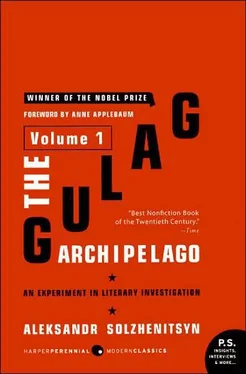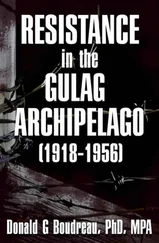I read them today touched with emotion. For example, the UPK—the Code of Criminal Procedure:
“Article 136: The interrogator does not have the right to extract testimony or a confession from an accused by means of compulsion and threats.” (It was as though they had foreseen it!)
“Article 111: The interrogator is obliged to establish clearly all the relevant facts, both those tending toward acquittal and any which might lessen the accused’s measure of guilt.”
But it was I who helped establish Soviet power in October! It was I who shot Kolchak! I took part in the dispossession of the kulaks! I saved the state ten million rubles in lowered production costs! I was wounded twice in the war! I have three orders and decorations.
“You’re not being tried for that!” History… the bared teeth of the interrogator: “Whatever good you may have done has nothing to do with the case.”
“Article 139: The accused has the right to set forth his testimony in his own hand, and to demand the right to make corrections in the deposition written by the interrogator.”
Oh, if we had only known that in time! But what I should say is: If that were only the way it really was! We were always vainly imploring the interrogator not to write “my repulsive, slanderous fabrications” instead of “my mistaken statements,” or not to write “our underground weapons arsenal” instead of “my rusty Finnish knife.”
If only the defendants had first been taught some prison science! If only interrogation had been run through first in rehearsal, and only afterward for real…. They didn’t, after all, play that interrogation game with the second-termers of 1948: it would have gotten them nowhere. But newcomers had no experience, no knowledge! And there was no one from whom to seek advice.
The loneliness of the accused! That was one more factor in the success of unjust interrogation! The entire apparatus threw its full weight on one lonely and inhibited will. From the moment of his arrest and throughout the entire shock period of the interrogation the prisoner was, ideally, to be kept entirely alone. In his cell, in the corridor, on the stairs, in the offices, he was not supposed to encounter others like himself, in order to avoid the risk of his gleaning a bit of sympathy, advice, support from someone’s smile or glance. The Organs did everything to blot out for him his future and distort his present: to lead him to believe that his friends and family had all been arrested and that material proof of his guilt had been found. It was their habit to exaggerate their power to destroy him and those he loved as well as their authority to pardon (which the Organs didn’t even have). They pretended that there was some connection between the sincerity of a prisoner’s “repentance” and a reduction in his sentence or an easing of the camp regimen. (No such connection ever existed.) While the prisoner was still in a state of shock and torment and totally beside himself, they tried to get from him very quickly as many irreparably damaging items of evidence as possible and to implicate with him as many totally innocent persons as possible. Some defendants became so depressed in these circumstances that they even asked not to have the depositions read to them. They could not stand hearing them. They asked merely to be allowed to sign them, just to sign and get it over with. Only after all this was over would the prisoner be released from solitary into a large cell, where, in belated desperation, he would discover and count over his mistakes one by one.
How was it possible not to make mistakes in such a duel? Who could have failed to make a mistake?
We said that “ideally he was to be kept alone.” However, in the overcrowded prisons of 1937, and, for that matter, of 1945 as well, this ideal of solitary confinement for a newly arrested defendant could not be attained. Almost from his first hours, the prisoner was in fact in a terribly overcrowded common cell.
But there were virtues to this arrangement, too, which more than made up for its flaws. The overcrowding of the cells not only took the place of the tightly confined solitary “box” but also assumed the character of a first-class torture in itself… one that was particularly useful because it continued for whole days and weeks—with no effort on the part of the interrogators. The prisoners tortured the prisoners! The jailers pushed so many prisoners into the cell that not every one had even a piece of floor; some were sitting on others’ feet, and people walked on people and couldn’t even move about at all. Thus, in the Kishinev KPZ’s—Cells for Preliminary Detention—in 1945, they pushed eighteen prisoners into a cell designed for the solitary confinement of one person; in Lugansk in 1937 it was fifteen. [72] 22. And the interrogation there lasted eight to ten months at a time. “Maybe Klim [Voroshilov] had one of these to himself,” said the fellows there. (Was he, in fact, ever imprisoned?)
And in 1938 Ivanov-Razumnik found one hundred forty prisoners in a standard Butyrki cell intended for twenty-five—with toilets so overburdened that prisoners were taken to the toilet only once a day, sometimes at night; and the same thing was true of their outdoor walk as well. [73] 23. That same year in the Butyrki, those newly arrested, who had already been processed through the bath and the boxes, sat on the stairs for several days at a stretch, waiting for departing prisoner transports to leave and release space in the cells. T-v had been imprisoned in the Butyrki seven years earlier, in 1931, and says that it was overcrowded under the bunks and that prisoners lay on the asphalt floor. I myself was imprisoned seven years later, in 1945, and it was just the same. But recently I received from M. K. B-ch valuable personal testimony about overcrowding in the Butyrki in 1918. In October of that year—during the second month of the Red Terror—it was so full that they even set up a cell for seventy women in the laundry. When, then, was the Butyrki not crowded?
It was Ivanov-Razumnik who in the Lubyanka reception “kennel” calculated that for weeks at a time there were three persons for each square yard of floor space (just as an experiment, try to fit three people into that space!). [74] 24. But this, too, is no miracle: in the Vladimir Internal Prison in 1948, thirty people had to stand in a cell ten feet by ten feet in size! (S. Potapov.)
In this “kennel” there was neither ventilation nor a window, and the prisoners’ body heat and breathing raised the temperature to 40 or 45 degrees Centigrade—104 to 113 degrees Fahrenheit—and everyone sat there in undershorts with their winter clothing piled beneath them. Their naked bodies were pressed against one another, and they got eczema from one another’s sweat. They sat like that for weeks at a time, and were given neither fresh air nor water—except for gruel and tea in the morning. [75] 25. By and large there is a good deal in Ivanov-Razumnik’s book that is superficial and personal, and there are many exhaustingly monotonous jokes. But the real life of the cells in the 1937-1938 period is very well described there.
And if at the same time the latrine bucket replaced all other types of toilet (or if, on the other hand, there was no latrine bucket for use between trips to an outside toilet, as was the case in several Siberian prisons); and if four people ate from one bowl, sitting on each other’s knees; and if someone was hauled out for interrogation, and then someone else was pushed in beaten up, sleepless, and broken; and if the appearance of such broken men was more persuasive than any threats on the part of the interrogators; and if, by then, death and any camp whatever seemed easier to a prisoner who had been left unsummoned for months than his tormented current situation—perhaps this really did replace the theoretically ideal isolation in solitary. And you could not always decide in such a porridge of people with whom to be forthright; and you could not always find someone from whom to seek advice. And you would believe in the tortures and beatings not when the interrogator threatened you with them but when you saw their results on other prisoners.
Читать дальше












